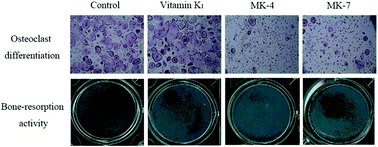The inhibitory effect of vitamin K on RANKL-induced osteoclast differentiation and bone resorption
Abstract
To further understand the correlation between vitamin K and bone metabolism, the effects of vitamins K1, menaquinone-4 (MK-4), and menaquinone-7 (MK-7) on RANKL-induced osteoclast differentiation and bone resorption were comparatively investigated. Vitamin K2 groups (MK-4 and MK-7) were found to significantly inhibit RANKL-medicated osteoclast cell formation of bone marrow macrophages (BMMs) in a dose-dependent manner, without any evidence of cytotoxicity. The mRNA expression of specific osteoclast differentiation markers, such as c-Fos, NFATc1, OSCAR, and TRAP, as well as NFATc1 protein expression and TRAP activity in RANKL-treated BMMs were inhibited by vitamin K2, although MK-4 exhibited a significantly greater efficiency compared to MK-7. In contrast, the same dose of vitamin K1 had no inhibitory effect on RANKL-induced osteoclast cell formation, but increased the expression of major osteoclastogenic genes. Interestingly, vitamins K1, MK-4 and MK-7 all strongly inhibited osteoclastic bone resorption (p < 0.01) in a dose dependent manner. These results suggest that vitamins K1, MK-4 and MK-7 have anti-osteoporotic properties, while their regulation effects on osteoclastogenesis are somewhat different.


 Please wait while we load your content...
Please wait while we load your content...